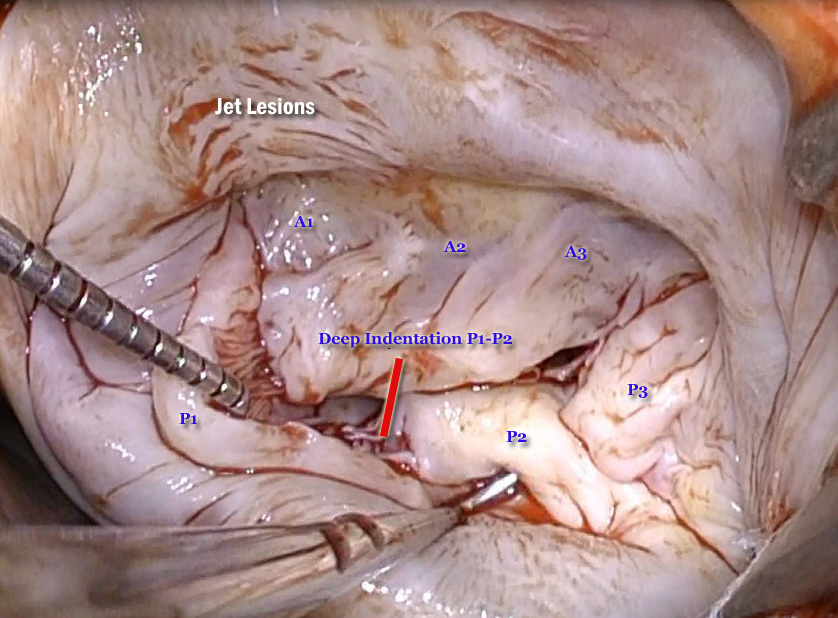Brief Case Description
The patient is a 64 year-old male with asymptomatic severe mitral regurgitation followed by his cardiologist for several years and now presenting with worsening left ventricular function. During the last few years, he was diagnosed with several illnesses including lymphoma and gastro-intestinal bleeding delaying his referral for reconstructive surgery. He also underwent an AICD insertion for several episodes of ventricular arrhythmia.
Transthoracic and transesophageal echocardiography showed type II mitral valve dysfunction with posterior leaflet prolapse (parasternal long-axis and apical four-chamber views). On Doppler echocardiography, there was an anteriorly directed jet. Quantitative measurements showed severe mitral regurgitation with a regurgitant orifice area of 44 mm2 and a regurgitant volume of 93 mL. Left ventricular end diastolic diameter was increased to 6 cm. Left ventricular ejection fraction was decreased to 45 %. There was moderate (3+) tricuspid regurgitation. Right ventricular function was moderately decreased.
The patient was referred for reconstructive mitral and tricuspid valve surgery.
Preoperative cardiac catheterization showed normal coronaries and normal right-sided pressures.
Operative Procedure
Intraoperative Transesophageal Echocardiography
Intraoperative transesophageal echocardiography confirmed the diagnosis of posterior leaflet prolapse involving the P2 segment. Doppler echocardiography showed an anteriorly directed jet and mitral regurgitation was graded severe.
Three-dimensional rendering of the mitral valve showed type II- P2 dysfunction. It also visualized deep indentations between P1-P2 and P2-P3 segments.
Mitral Valve Analysis
Following the left atriotomy, we first performed valve analysis using Carpentier's reference point technique. We confirmed the normal leaflet motion of P1 by pulling its free edge upward with a nerve hook. The P1 segment was neither prolapsing as its free edge was not overriding the plane of the mitral annulus nor restricted. The P1 segment as well as other segments of the valve were mildly billowing. Using a second hook, other valve segments were examined in a systematic manner and compared to P1 to verify if they were prolapsing. In this case, valve analysis confirmed the prolapse of the P2 segment due to chordae elongation. There was significant excess tissue of P2 segment. We also observed deep indentations between P1-P2 and P2-P3 segments. The anterior leaflet had normal leaflet motion with no prolapsing segments. The mitral annulus was dilated.


Following this complete echocardiographic and intraoperative valve analysis, we can summarize the pathophysiological triad as follows:
Etiology: Form fruste Barlow's disease
Lesions: Chordae elongation, secondary annular dilatation
Dysfunction: Type II- P2
Reconstructive Procedure
This was a case of extensive prolapse of P2 segment with deep indentations between P1-P2 and P2-P3 segments. Our strategy was to perform a quadrangular resection of P2 excising the most pathological portion of this segment followed by annular plication.
In the presence of these deep indentations, two important facts should be taken into consideration:
First, following quadrangular resection, the amount of remnant leaflet tissue may not be sufficient on each side to restore leaflet continuity with safety.
Second, these deep indentations may widen following leaflet reconstruction creating a new source of valve regurgitation.
In order to avoid these drawbacks, the first step of the operation should be to close these indentations to increase the amount of leaflet available for suturing and to eliminate a secondary source of mitral regurgitation. In this case, both these indentations were closed with 4-0 monofilament suture in a running fashion. Approximately 2 to 3 mm from these closed indentations, a limited quadrangular resection of P2 segment was performed. The secondary chordae close to the edges of the resection were cut to facilitate leaflet mobilization. The height of remnants P1 and P3 was about 15 mm. The gap between the two segments was 16 mm.
we used annular plication technique, using three sutures, to reduce the size of the posterior annulus and to approximate P1 and P3 segments. Leaflet continuity was restored with 5-0 monofilament sutures.
Valve analysis following reconstruction showed a similar height between reference P1 and the reconstructed leaflet segment suggesting a perfect result. The valve analysis using two hooks is critical to confirm that there is no residual prolapse and that we have not created any restricted leaflet motion. The suture lines were examined carefully to identify any residual defects.
Finally, a remodeling annuloplasty was performed with a 34 mm Carpentier Edwards Physio ring.
A saline test was performed with disappointing results without obtaining a surface of coaptation and we observed significant residual regurgitation. The result of the saline test was in contrast with our valve analysis using two hooks which showed a perfect reconstructive procedure with the restoration of the appropriate height of the posterior leaflet and a normal anterior leaflet. It is important to note that in patients with left ventricular enlargement (6 cm in this case), the saline test is not always reliable because it is difficult to fully distend the left ventricle. In these cases where there is a discrepancy between post-reconstruction valve analysis and the saline test, the surgeon's final decision should be based on the former provided that he/she has correctly applied Carpentier's principles of valve reconstruction.
The patient also underwent a tricuspid remodeling annuloplasty with a 34 mm Carpentier Edwards Physio tricuspid ring for type I dysfunction due to annular dilatation (See Type I dysfunction).
Postbypass Transesophageal Echocardiography
Mid esophageal long axis and four-chamber views showed a competent mitral valve with no residual regurgitation confirming our post-reconstruction valve analysis. The tricuspid valve was competent. Three-dimensional rendering of the mitral valve also showed an excellent result.